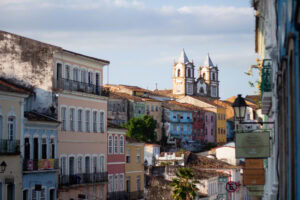From January to November, 125,000 foreigners arrived at Bahia’s airports.
Bahia’s tourism sector has announced a significant growth in international arrivals. From January to November this year, 125,000 foreign visitors landed at Bahia’s airports, representing a 60% increase compared to the same period last year, when 78,000 foreign passengers arrived.
According to the report, over the past eleven months, Bahia accounted for 41.3% of all international tourist traffic to Northeastern Brazil, with more than 125,000 visitors. Bahia’s leadership placed it ahead of Ceará, which welcomed 85,700 foreigners, followed by Pernambuco with 57,700.
In response to the surge in demand, Bahia has invested in expanding its tourism infrastructure and improving service quality to enhance the visitor experience. Attracting new international flights has also become a priority, along with initiatives to strengthen Bahia’s presence in strategic markets around the world.
Bahia’s positive performance reflects the growing appeal of the state to international tourists, who are eager to explore its rich cultural, natural, and historical offerings. The expectation is that the state will continue to attract a significant number of international visitors, solidifying its position as one of Brazil’s and the Northeast’s top travel destinations.
Bahia is a destination brimming with attractions, tourist spots, culture, gastronomy, and diversity. With over 560,000 square kilometers – making it the fifth-largest state in Brazil by area, divided into 417 municipalities – Bahia draws thousands of tourists every year, not just during the summer. Bahia is a year-round destination.
Salvador, the capital of Bahia and the first capital of Brazil, proudly holds the title of the city with the largest black population outside Africa. The longest coastline in Brazil is also found here, with over 1,100 kilometers of coastline offering a stunning diversity of landscapes and experiences for both locals and tourists.
For travelers, the state offers options for all types of trips, whether for couples, singles, families, business, or leisure. With more than 268,000 hotel rooms, the accommodation options include renowned names like Fasano, Novotel, Grand Palladium, Accor, Tivoli, and other major brands.
To fly in and see the natural beauty from above, the state has 18 airports, including two international, five national, seven regional, and one private. In addition to national carriers, the destination has flights operated by Air France, Air Europa, TAP, Aerolíneas Argentinas, and Sky Airlines.
The state is divided into 13 tourist zones, each with its unique charm, with the Bay of All Saints being one of the most important tourist zones in Bahia.
Bahia’s beaches remain the top choice for tourists visiting the state. However, a variety of other activities are also offered, including whale watching and diving. Did you know that Salvador is also the largest urban dive tourism hub in Brazil?
Bahia also allows visitors to experience quilombola communities through Community-Based Tourism (TBC), a niche that has gained international recognition for its sustainable and authentic approach. This type of tourism gives visitors the chance to experience quilombola communities up close, where deep cultural traditions are preserved, linked both to African heritage and Indigenous culture.
Experiences in these communities include immersions in history and ancestral practices, such as visits to Indigenous villages, which have also become attractive points for tourists. In some of these villages, visitors can even sleep on-site and live with Indigenous families.
Chocolate production in the state is also a major draw for visitors. To complement Bahia’s flavors, wine tourism is flourishing, particularly in Chapada Diamantina, where six wineries are now recognized for producing wines and juices.
In Chapada Diamantina, visitors can tour wineries, learn about grape and wine production, and enjoy an immersive experience in a setting of natural beauty. Additionally, the São Francisco region offers a unique wine tourism experience, with wineries cultivating grapes under full sun and focusing on producing white wines and sparkling wines.
These wine tourism routes, which include guided tours, tastings, and immersion in the local winemaking culture, are located near the Sobradinho Lake, offering visitors a unique combination of learning, culture, and breathtaking landscapes.
Want to learn more about Bahia? Check out our guides:



I had started smoking or Com batt Physically not too